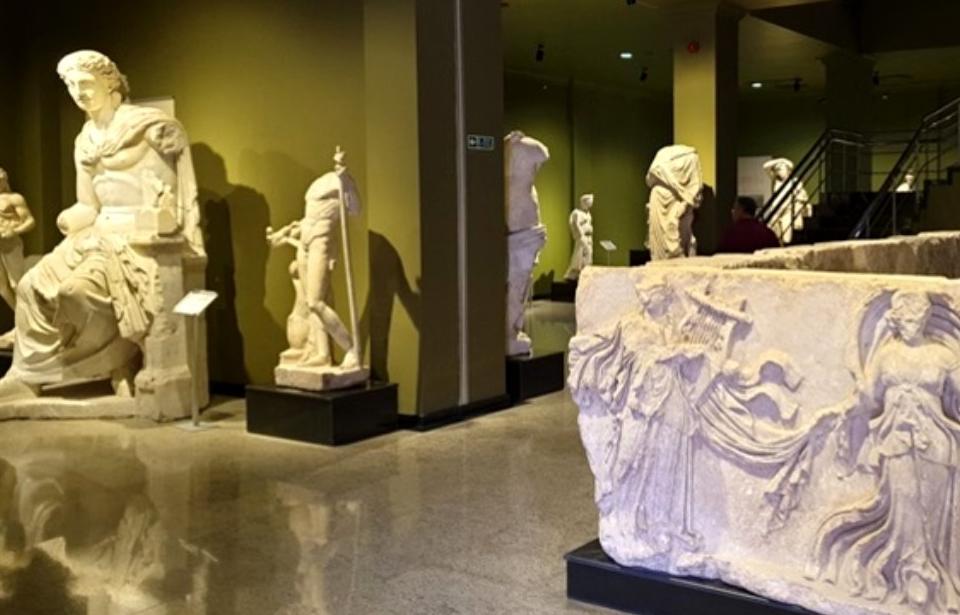Istanbul exhibit to highlight ancient city Sagalassos
ISTANBUL

A new exhibition at the Yapı Kredi Cultural Center offers a glimpse into the ancient urban life in Sagalassos, says deputy director of excavation works
Hundreds of artifacts from the ancient city of Sagalassos, located in the southern province of Burdur’s Ağlasun district, are on display at a new exhibition opened on Nov. 27 at the Yapı Kredi Cultural Center in Istanbul.
One of the best-preserved ancient cities of the Mediterranean, Sagalassos is included in the Tentative List of UNESCO World Heritage Sites.
The exhibition, titled “Meanwhile in the Mountains: Sagalassos,” will be open through May 28, 2020.
Peter Talloen, deputy director of the excavation works on the site, told the state-run Anadolu Agency that the use of original material during the restoration work was what makes Sagalassos unique.
The Sagalassos ancient city in Aglasun district of Burdur province is 1,750 meters above sea level and dates back 5,000 years.
Because the city was located at a high place, a lot of the ancient structure is exactly how it was in the 13th century when it was abandoned, said the professor of Turkey’s Süleyman Demirel University.
Talloen, who began working at the site as a student in 1995, said: “People visiting the site get the real impression of what the ancient urban life, living in a city meant in antiquity.”
He said the site is very close to its original state. “This place was really abandoned, the population moved down to the valley and they didn’t take any ancient stone or any object from the ancient city, everything was left as it was.”
The exhibition introduces visitors to the ancient city of Sagalassos, founded on the southern slopes of the Taurus mountain range, and the history of the region of Pisidia.
From Statues of Gods and Goddesses to Mammoth Bones, the exhibition contains many and divergent historical objects from mammoth bones from the Burdur region proving that they lived in prehistorical Anatolia, to the massive statues of the Roman emperors Marcus Aurelius and Hadrian.
Objects like the terracotta figurines of gods, goddesses and heroes reflecting belief rituals, a statuette of Alexander the Great, stone tools, decorative items, cooking and food vessels from Sagalassos and the region of Pisidia from different periods, shed a light on the past and the daily and social life of the residents of ancient Sagalassos.
At the entrance to the museum visitors are received by the statue of emperor Marcus Aurelius that was unearthed at the Roman Baths at Sagalassos.
Originally approximately five meters high and carved in white marble, the head, arms and legs are displayed at the exhibition. The restoration of the Antonin Fountain at Sagalassos, which was built in the reign of Marcus Aurelius, was completed in 2010. The head of emperor Hadrian, who named Sagalassos Pisidia’s first city, can also be seen at the exhibition. The emperors Hadrian and Marcus Aurelius are among Rome’s Five Good emperors.
Meeting the Pisidians
Experts have recreated the faces belonging to the skulls found during the Sagalassos excavation of a Roman man dated to the 3rd century BC and to a Byzantine woman dated to the 11th century.
Excavation director Jeroen Poblome, who characterizes face reconstruction as a combination of science and creativity, notes that the digital face reconstructions have an accuracy of 75 percent.
The Pisidians, whose real names are unknown, have been named Rhodon and Eirene by the research team. With the busts of Rhodon and Eirene having been brought to the exhibition, visitors have the opportunity to meet ancient Pisidians.
The Upper Agora unearthed during the Sagalassos excavations as well as the best examples of statues of emperors, gods and heroes recovered there are also on show.
















